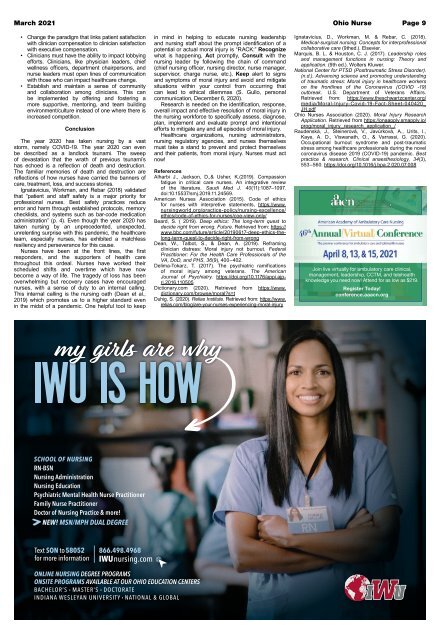Ohio Nurse - March 2021
You also want an ePaper? Increase the reach of your titles
YUMPU automatically turns print PDFs into web optimized ePapers that Google loves.
<strong>March</strong> <strong>2021</strong> <strong>Ohio</strong> <strong>Nurse</strong> Page 9<br />
• Change the paradigm that links patient satisfaction<br />
with clinician compensation to clinician satisfaction<br />
with executive compensation.<br />
• Clinicians must have the ability to impact lobbying<br />
efforts. Clinicians, like physician leaders, chief<br />
wellness officers, department chairpersons, and<br />
nurse leaders must open lines of communication<br />
with those who can impact healthcare change.<br />
• Establish and maintain a sense of community<br />
and collaboration among clinicians. This can<br />
be implemented by offering and fostering a<br />
more supportive, mentoring, and team building<br />
environment/culture instead of one where there is<br />
increased competition.<br />
Conclusion<br />
The year 2020 has taken nursing by a vast<br />
storm, namely COVID-19. The year 2020 can even<br />
be described as a landlock tsunami. The sweep<br />
of devastation that the wrath of previous tsunami’s<br />
has echoed is a reflection of death and destruction.<br />
The familiar memories of death and destruction are<br />
reflections of how nurses have carried the banners of<br />
care, treatment, loss, and success stories.<br />
Ignatavicius, Workman, and Rebar (2018) validated<br />
that “patient and staff safety is a major priority for<br />
professional nurses. Best safety practices reduce<br />
error and harm through established protocols, memory<br />
checklists, and systems such as bar-code medication<br />
administration” (p. 4). Even though the year 2020 has<br />
taken nursing by an unprecedented, unexpected,<br />
unrelenting surprise with this pandemic, the healthcare<br />
team, especially nurses, has exhibited a matchless<br />
resiliency and perseverance for this cause.<br />
<strong>Nurse</strong>s have been at the front lines, the first<br />
responders, and the supporters of health care<br />
throughout this ordeal. <strong>Nurse</strong>s have worked their<br />
scheduled shifts and overtime which have now<br />
become a way of life. The tragedy of loss has been<br />
overwhelming but recovery cases have encouraged<br />
nurses, with a sense of duty to an internal calling.<br />
This internal calling is the nursing oath (Dean et al.,<br />
2019) which promotes us to a higher standard even<br />
in the midst of a pandemic. One helpful tool to keep<br />
in mind in helping to educate nursing leadership<br />
and nursing staff about the prompt identification of a<br />
potential or actual moral injury is “RACK:” Recognize<br />
what is happening, Act promptly, Consult with the<br />
nursing leader by following the chain of command<br />
(chief nursing officer, nursing director, nurse manager,<br />
supervisor, charge nurse, etc.), Keep alert to signs<br />
and symptoms of moral injury and avoid and mitigate<br />
situations within your control from occurring that<br />
can lead to ethical dilemmas (S. Gullo, personal<br />
communication, December 6, 2020).<br />
Research is needed on the identification, response,<br />
overall impact and effective resolution of moral injury in<br />
the nursing workforce to specifically assess, diagnose,<br />
plan, implement and evaluate prompt and intentional<br />
efforts to mitigate any and all episodes of moral injury.<br />
Healthcare organizations, nursing administrators,<br />
nursing regulatory agencies, and nurses themselves<br />
must take a stand to prevent and protect themselves<br />
and their patients, from moral injury. <strong>Nurse</strong>s must act<br />
now!<br />
References<br />
Alharbi J., Jackson, D.,& Usher, K.(2019). Compassion<br />
fatigue in critical care nurses. An integrative review<br />
of the literature. Saudi Med J. 40(11):1087–1097.<br />
doi:10.15537/smj.2019.11.24569.<br />
American <strong>Nurse</strong>s Association (2015). Code of ethics<br />
for nurses with interpretive statements, https://www.<br />
nursingworld.org/practice-policy/nursing-excellence/<br />
ethics/code-of-ethics-for-nurses/coe-view-only/<br />
Beard, S. ( 2019). Deep ethics: The long-term quest to<br />
decide right from wrong. Future. Retrieved from: https://<br />
www.bbc.com/future/article/20190617-deep-ethics-thelong-term-quest-to-decide-right-from-wrong<br />
Dean, W., Talbot, S., & Dean, A. (2019). Reframing<br />
clinician distress: Moral injury not burnout. Federal<br />
Practitioner: For the Health Care Professionals of the<br />
VA, DoD, and PHS, 36(9), 400–402.<br />
Delima-Tokarz, T. (2017). The psychiatric ramifications<br />
of moral injury among veterans. The American<br />
Journal of Psychiatry. https://doi.org/10.1176/appi.ajprj.2016.110505<br />
Dictionary.com (2020). Retrieved from https://www.<br />
dictionary.com/browse/moral?s=t<br />
Duhig, S. (2020). Relias Institute. Retrieved from: https://www.<br />
relias.com/blog/are-your-nurses-experiencing-moral-injury<br />
Ignatavicius, D., Workman, M. & Rebar, C. (2018).<br />
Medical-surgical nursing: Concepts for interprofessional<br />
collaborative care (9thed.). Elsevier.<br />
Marquis, B. L. & Houston, C. J. (2017). Leadership roles<br />
and management functions in nursing: Theory and<br />
application. (9th ed.). Wolters Kluwer.<br />
National Center for PTSD (Posttraumatic Stress Disorder).<br />
(n.d.). Advancing science and promoting understanding<br />
of traumatic stress: Moral injury in healthcare workers<br />
on the frontlines of the Coronavirus (COVID -19)<br />
outbreak. U.S. Department of Veterans Affairs.<br />
Retrieved from: https://www.theschwartzcenter.org/<br />
media/Moral-Injury-Covid-19-Fact-Sheet-040420_<br />
JH.pdf<br />
<strong>Ohio</strong> <strong>Nurse</strong>s Association (2020). Moral Injury Research<br />
Application. Retrieved from https://onaapply.smapply.io/<br />
prog/moral_injury_research_application_/<br />
Raudenská, J., Steinerová, V., Javůrková, A., Urits, I.,<br />
Kaye, A. D., Viswanath, O., & Varrassi, G. (2020).<br />
Occupational burnout syndrome and post-traumatic<br />
stress among healthcare professionals during the novel<br />
coronavirus disease 2019 (COVID-19) pandemic. Best<br />
practice & research. Clinical anaesthesiology, 34(3),<br />
553–560. https://doi.org/10.1016/j.bpa.2 020.07.008<br />
Join live virtually for ambulatory care clinical,<br />
management, leadership, CCTM, and telehealth<br />
knowledge you need now! Attend for as low as $219.<br />
Register Today!<br />
conference.aaacn.org

















